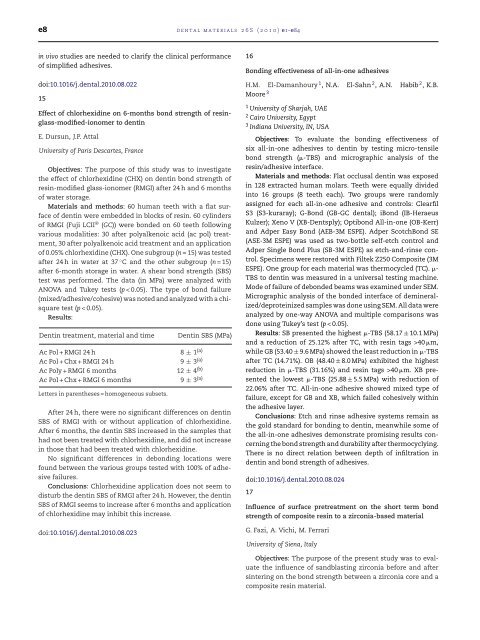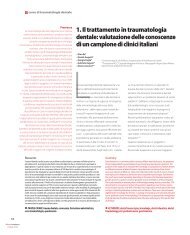Abstracts of the Academy of Dental Materials Annual ... - IsiRed
Abstracts of the Academy of Dental Materials Annual ... - IsiRed
Abstracts of the Academy of Dental Materials Annual ... - IsiRed
You also want an ePaper? Increase the reach of your titles
YUMPU automatically turns print PDFs into web optimized ePapers that Google loves.
e8 dental materials 26S (2010) e1–e84<br />
in vivo studies are needed to clarify <strong>the</strong> clinical performance<br />
<strong>of</strong> simplified adhesives.<br />
doi:10.1016/j.dental.2010.08.022<br />
15<br />
Effect <strong>of</strong> chlorhexidine on 6-months bond strength <strong>of</strong> resinglass-modified-ionomer<br />
to dentin<br />
E. Dursun, J.P. Attal<br />
University <strong>of</strong> Paris Descartes, France<br />
Objectives: The purpose <strong>of</strong> this study was to investigate<br />
<strong>the</strong> effect <strong>of</strong> chlorhexidine (CHX) on dentin bond strength <strong>of</strong><br />
resin-modified glass-ionomer (RMGI) after 24 h and 6 months<br />
<strong>of</strong> water storage.<br />
<strong>Materials</strong> and methods: 60 human teeth with a flat surface<br />
<strong>of</strong> dentin were embedded in blocks <strong>of</strong> resin. 60 cylinders<br />
<strong>of</strong> RMGI (Fuji LCII ® (GC)) were bonded on 60 teeth following<br />
various modalities: 30 after polyalkenoic acid (ac pol) treatment,<br />
30 after polyalkenoic acid treatment and an application<br />
<strong>of</strong> 0.05% chlorhexidine (CHX). One subgroup (n = 15) was tested<br />
after 24 h in water at 37 ◦ C and <strong>the</strong> o<strong>the</strong>r subgroup (n = 15)<br />
after 6-month storage in water. A shear bond strength (SBS)<br />
test was performed. The data (in MPa) were analyzed with<br />
ANOVA and Tukey tests (p < 0.05). The type <strong>of</strong> bond failure<br />
(mixed/adhesive/cohesive) was noted and analyzed with a chisquare<br />
test (p < 0.05).<br />
Results:<br />
Dentin treatment, material and time Dentin SBS (MPa)<br />
Ac Pol + RMGI 24 h 8 ± 1 (a)<br />
AcPol+Chx+RMGI24h 9 ± 3 (a)<br />
Ac Poly + RMGI 6 months 12 ± 4 (b)<br />
Ac Pol + Chx + RMGI 6 months 9 ± 3 (a)<br />
Letters in paren<strong>the</strong>ses = homogeneous subsets.<br />
After 24 h, <strong>the</strong>re were no significant differences on dentin<br />
SBS <strong>of</strong> RMGI with or without application <strong>of</strong> chlorhexidine.<br />
After 6 months, <strong>the</strong> dentin SBS increased in <strong>the</strong> samples that<br />
had not been treated with chlorhexidine, and did not increase<br />
in those that had been treated with chlorhexidine.<br />
No significant differences in debonding locations were<br />
found between <strong>the</strong> various groups tested with 100% <strong>of</strong> adhesive<br />
failures.<br />
Conclusions: Chlorhexidine application does not seem to<br />
disturb <strong>the</strong> dentin SBS <strong>of</strong> RMGI after 24 h. However, <strong>the</strong> dentin<br />
SBS <strong>of</strong> RMGI seems to increase after 6 months and application<br />
<strong>of</strong> chlorhexidine may inhibit this increase.<br />
doi:10.1016/j.dental.2010.08.023<br />
16<br />
Bonding effectiveness <strong>of</strong> all-in-one adhesives<br />
H.M. El-Damanhoury 1 , N.A. El-Sahn 2 , A.N. Habib 2 , K.B.<br />
Moore 3<br />
1 University <strong>of</strong> Sharjah, UAE<br />
2 Cairo University, Egypt<br />
3 Indiana University, IN, USA<br />
Objectives: To evaluate <strong>the</strong> bonding effectiveness <strong>of</strong><br />
six all-in-one adhesives to dentin by testing micro-tensile<br />
bond strength (�-TBS) and micrographic analysis <strong>of</strong> <strong>the</strong><br />
resin/adhesive interface.<br />
<strong>Materials</strong> and methods: Flat occlusal dentin was exposed<br />
in 128 extracted human molars. Teeth were equally divided<br />
into 16 groups (8 teeth each). Two groups were randomly<br />
assigned for each all-in-one adhesive and controls: Clearfil<br />
S3 (S3-kuraray); G-Bond (GB-GC dental); iBond (IB-Heraeus<br />
Kulzer); Xeno V (XB-Dentsply); Optibond All-in-one (OB-Kerr)<br />
and Adper Easy Bond (AEB-3M ESPE). Adper ScotchBond SE<br />
(ASE-3M ESPE) was used as two-bottle self-etch control and<br />
Adper Single Bond Plus (SB-3M ESPE) as etch-and-rinse control.<br />
Specimens were restored with Filtek Z250 Composite (3M<br />
ESPE). One group for each material was <strong>the</strong>rmocycled (TC). �-<br />
TBS to dentin was measured in a universal testing machine.<br />
Mode <strong>of</strong> failure <strong>of</strong> debonded beams was examined under SEM.<br />
Micrographic analysis <strong>of</strong> <strong>the</strong> bonded interface <strong>of</strong> demineralized/deproteinized<br />
samples was done using SEM. All data were<br />
analyzed by one-way ANOVA and multiple comparisons was<br />
done using Tukey’s test (p < 0.05).<br />
Results: SB presented <strong>the</strong> highest �-TBS (58.17 ± 10.1 MPa)<br />
and a reduction <strong>of</strong> 25.12% after TC, with resin tags >40 �m,<br />
while GB (53.40 ± 9.6 MPa) showed <strong>the</strong> least reduction in �-TBS<br />
after TC (14.71%). OB (48.40 ± 8.0 MPa) exhibited <strong>the</strong> highest<br />
reduction in �-TBS (31.16%) and resin tags >40 �m. XB presented<br />
<strong>the</strong> lowest �-TBS (25.88 ± 5.5 MPa) with reduction <strong>of</strong><br />
22.06% after TC. All-in-one adhesive showed mixed type <strong>of</strong><br />
failure, except for GB and XB, which failed cohesively within<br />
<strong>the</strong> adhesive layer.<br />
Conclusions: Etch and rinse adhesive systems remain as<br />
<strong>the</strong> gold standard for bonding to dentin, meanwhile some <strong>of</strong><br />
<strong>the</strong> all-in-one adhesives demonstrate promising results concerning<br />
<strong>the</strong> bond strength and durability after <strong>the</strong>rmocyclying.<br />
There is no direct relation between depth <strong>of</strong> infiltration in<br />
dentin and bond strength <strong>of</strong> adhesives.<br />
doi:10.1016/j.dental.2010.08.024<br />
17<br />
Influence <strong>of</strong> surface pretreatment on <strong>the</strong> short term bond<br />
strength <strong>of</strong> composite resin to a zirconia-based material<br />
G. Fazi, A. Vichi, M. Ferrari<br />
University <strong>of</strong> Siena, Italy<br />
Objectives: The purpose <strong>of</strong> <strong>the</strong> present study was to evaluate<br />
<strong>the</strong> influence <strong>of</strong> sandblasting zirconia before and after<br />
sintering on <strong>the</strong> bond strength between a zirconia core and a<br />
composite resin material.



